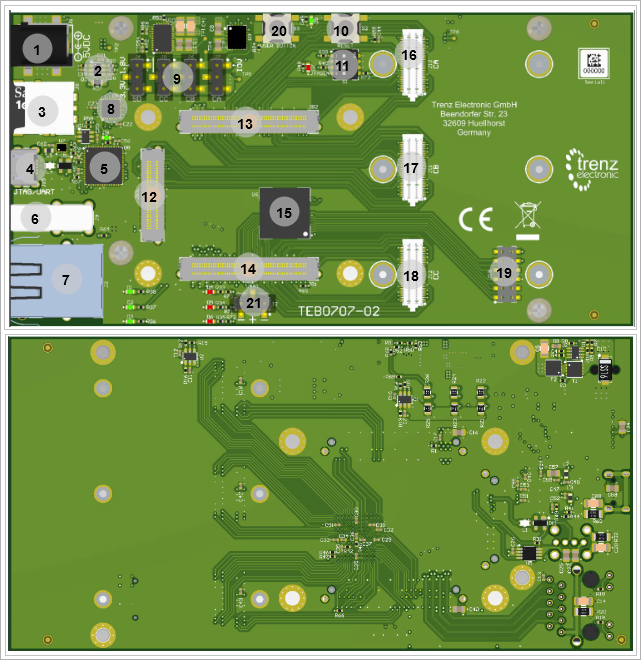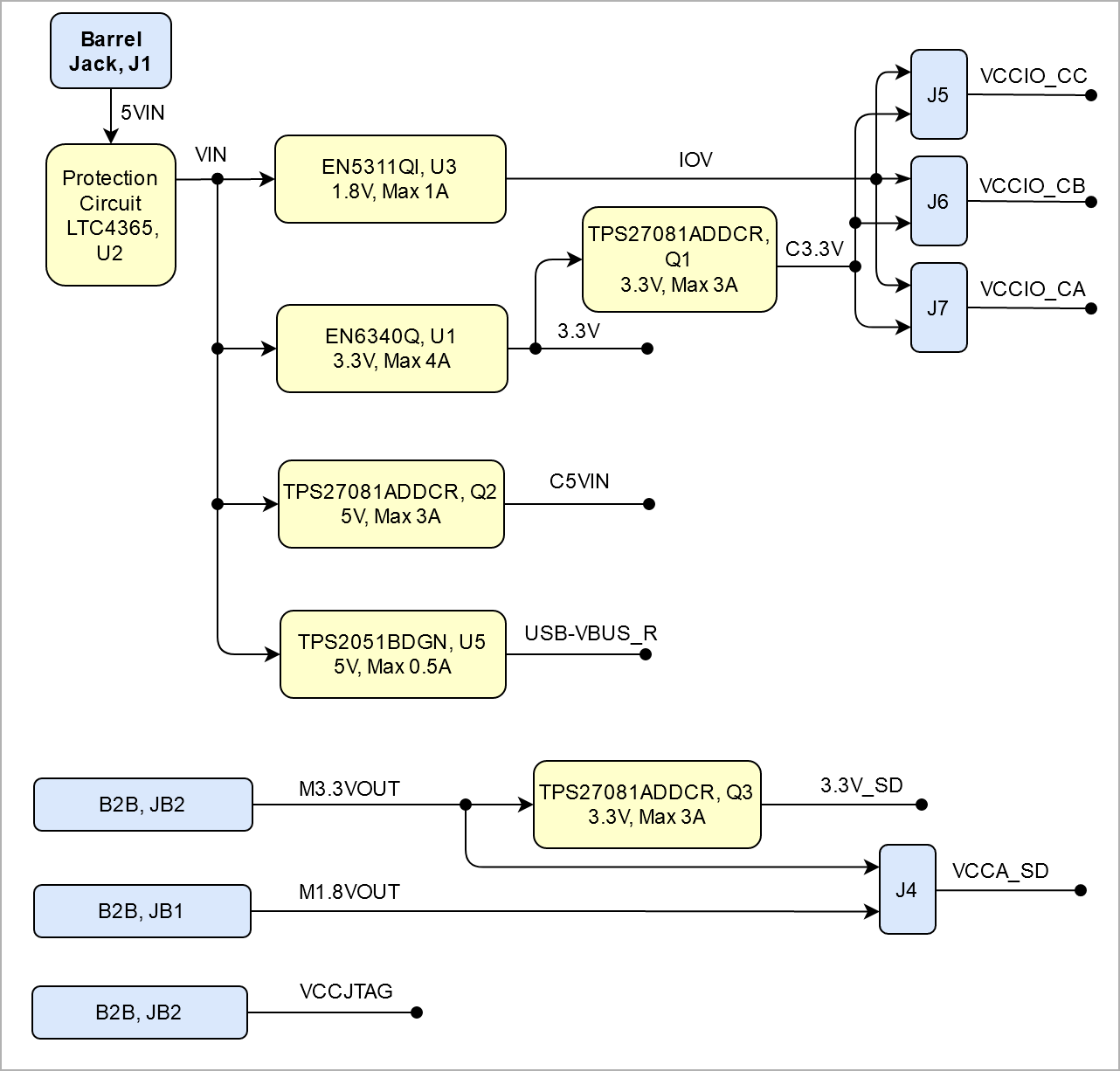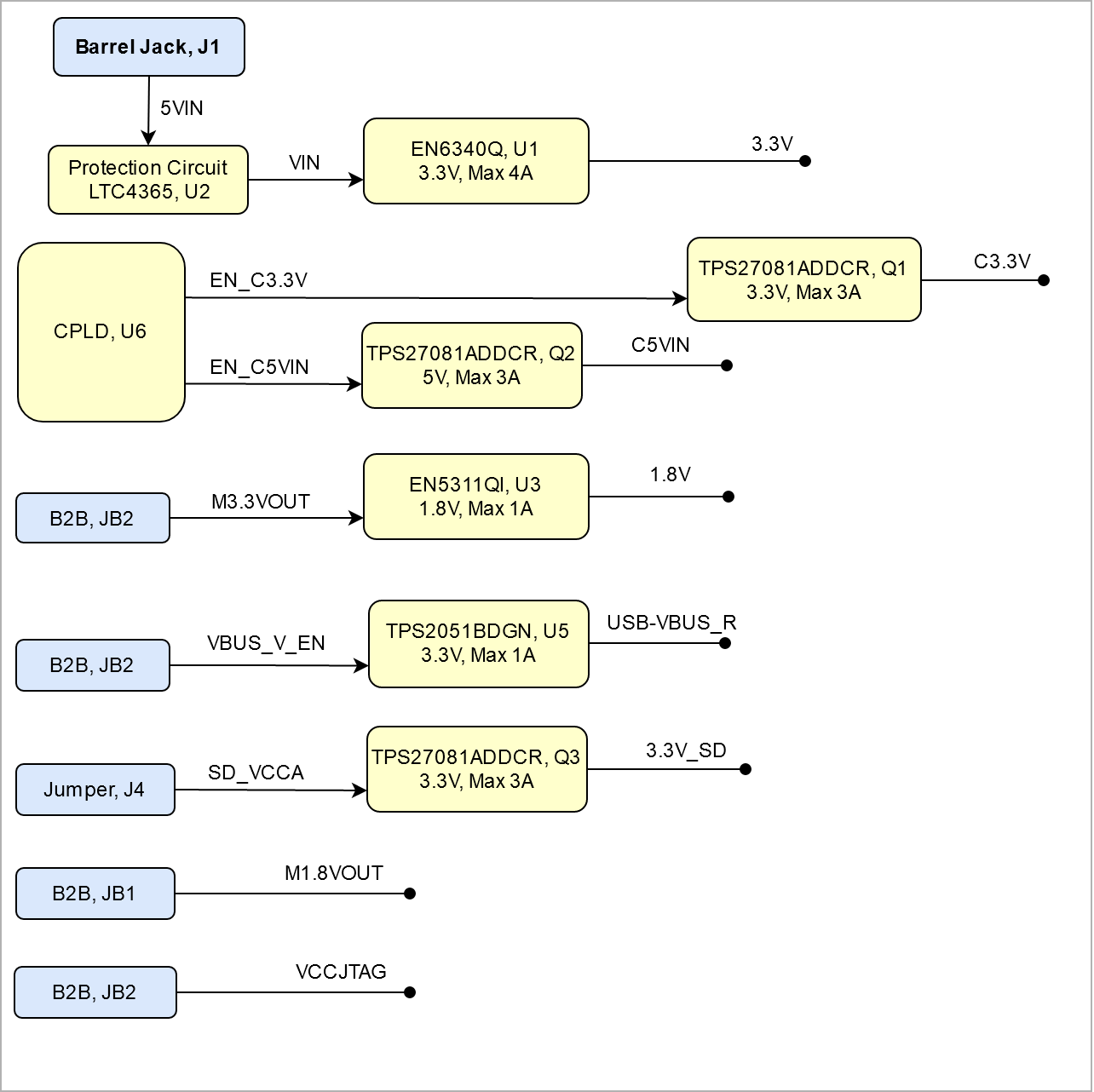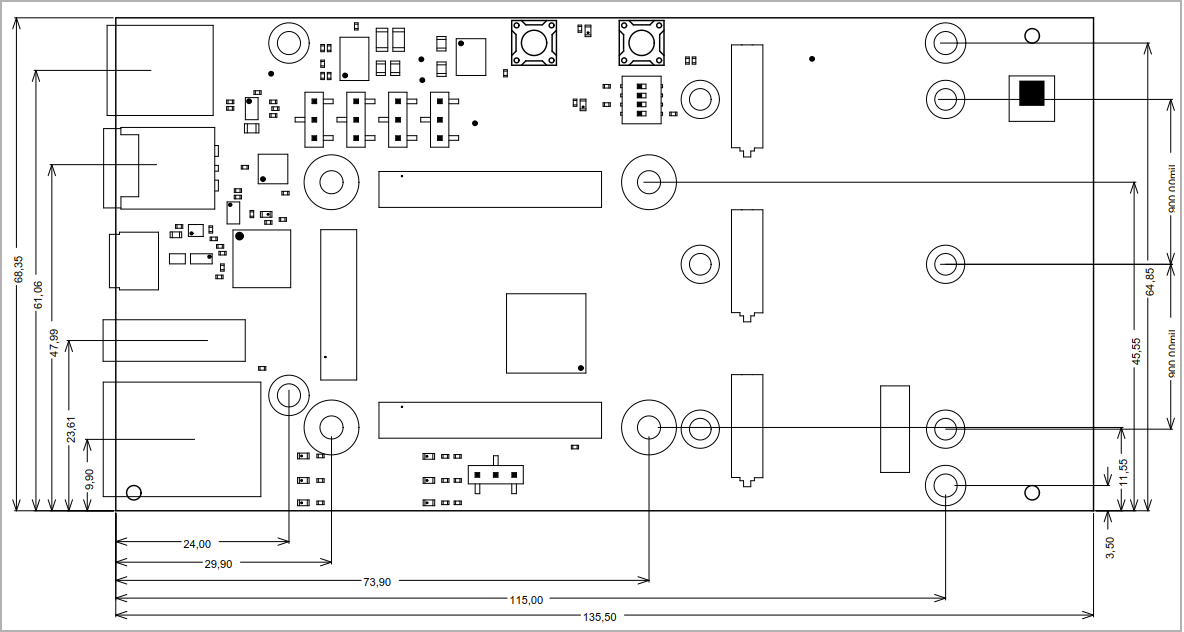Template Revision 2.12
- Module: TRM Name always "TE Series Name" +TRM
Example: "TE0728 TRM" - Carrier: TRM Name usually "TEB Series Name" +TRM
Example: "TEB0728 TRM"
|
<!-- tables have all same width (web max 1200px and pdf full page(640px), flexible width or fix width on menu for single column can be used as before) -->
<style>
.wrapped{
width: 100% !important;
max-width: 1200px !important;
}
</style> |
----------------------------------------------------------------------- |
Note for Download Link of the Scroll ignore macro: |
Table of Contents 
|
Overview
The Trenz Electronic TEB0707 is a carrier for 4 x 5 Trenz Electronic modules. It provides three high speed and one low speed CRUVI extension connectors. For more information, please refer to the CRUVI B2B Connectors. The TEB0707 is integrated with an Intel MAX10 FPGA as system controller and is equipped with a Micro USB2.0 Socket with FTDI to JTAG/UART solution, RJ45 LAN Socket, USB A Socket, Micro SD Card Socket, User LEDs, Push Buttons and DIP Switches for controlling the SoM.
Refer to http://trenz.org/teb0707-info for the current online version of this manual and other available documentation.
Key Features
Note:
'description: Important components and connector or other Features of the module
→ please sort and indicate assembly options Key Features' must be split into 6 main groups for modules and mainboards: - SoC/FPGA
- Package: SFVC784
- Device: ZU2...ZU5*
- Engine: CG, EG, EV*
- Speed: -1LI, -2LE,*, **
- Temperature: I, E,*, **
- RAM/Storage
- Low Power DDR4 on PS
- Data width: 32bit
- Size: def. 2GB*
- Speed:***
- eMMC
- Data width: 8Bit
- size: def. 8GB *
- QSPI boot Flash in dual parallel mode (size depends on assembly version)
- Data width: 8bit
- size: def. 128MB *
- HyperRAM/Flash (optional, default not assembled)
- MAC address serial EEPROM with EUI-48™ node identity (Microchip 24AA025E48)
- On Board
- Lattice LCMXO2
- PLL SI5338
- Gigabit Ethernet transceiver PHY (Marvell Alaska 88E1512)
- Hi-speed USB2 ULPI transceiver with full OTG support (Microchip USB3320C)
- Interface
- 132 x HP PL I/Os (3 banks)
- ETH
- USB
- 4 GTR (for USB3, Sata, PCIe, DP)
- MIO for UART
- MIO for SD
- MIO for PJTAG
- JTAG
- Ctrl
- Power
- 3.3V-5V Main Input
- 3.3V Controller Input
- Variable Bank IO Power Input
- Dimension
- Notes
- * depends on assembly version
- ** also non low power assembly options possible
- *** depends on used U+ Zynq and DDR4 combination
Key Features' must be split into 6 main groups for carrier: - Modules
- TE0808, TE807, TE0803,...
- RAM/Storage
- On Board
- Interface
- E.g. ETH, USB, B2B, Display port
- Power
- E.g. Input supply voltage
- Dimension
|
- Modules
- 4x5 Trenz Electronic modules
- RAM/Storage
- EEPROM (FTDI Configuration)
- On Board
- Intel Max 10 FPGA
- FTDI FT2223
- 6x User LEDs (3x green, 3x red)
- 2x Status LED
- DIP Switch
- Push Buttons
- Interface
- Gigabit RJ45 LAN socket
- SD Card socket
- Micro USB2.0 Socket
- USB A Socket
- 3x High Speed CRUVI B2B Connectors
- 1x Low Speed CRUVI B2B Connector
- 4x Jumpers
- Power
- Dimension
- Notes
Block Diagram
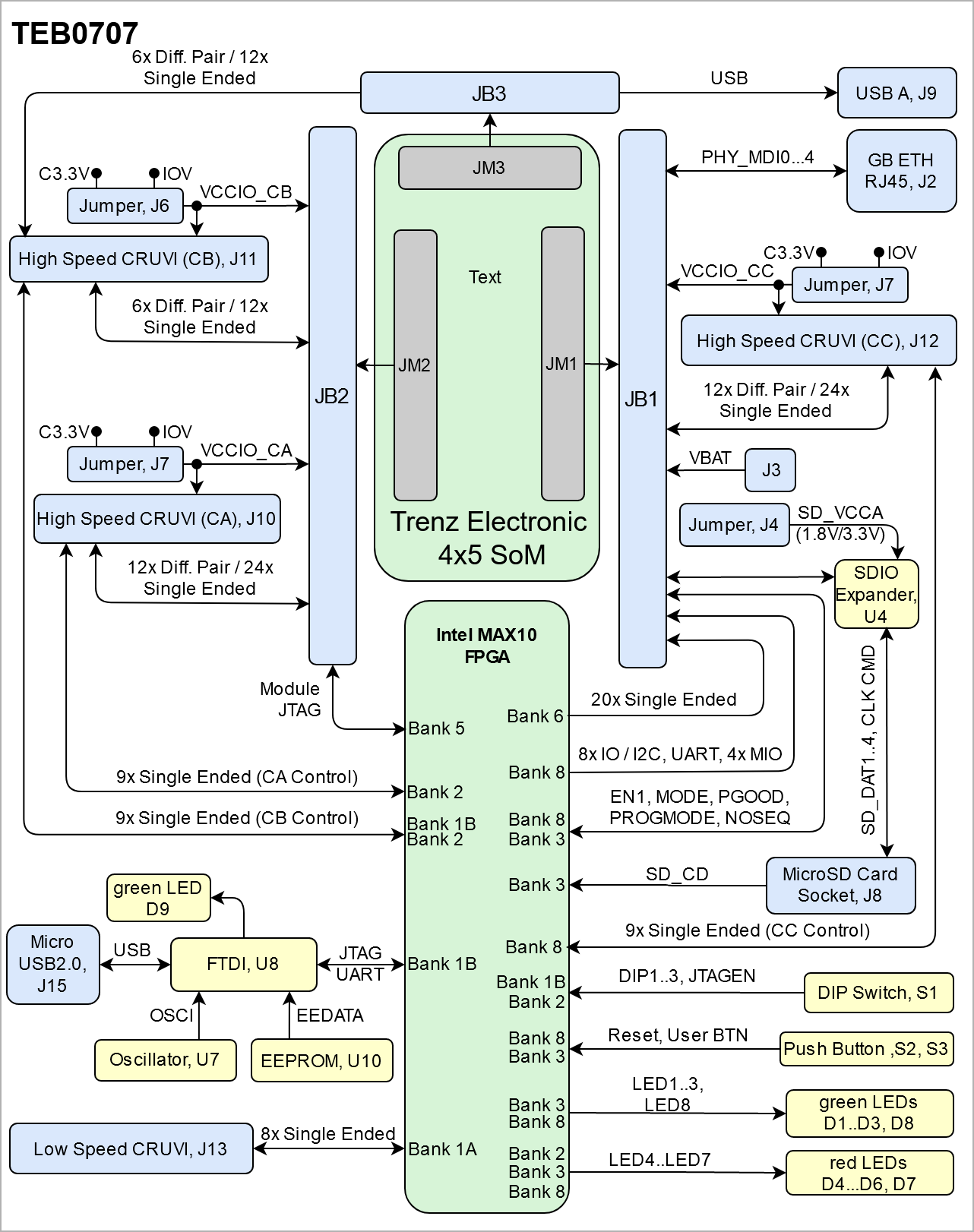
| |
|
Main Components
Notes : - Picture of the PCB (top and bottom side) with labels of important components
- Add List below
|
- Barrel Jack Power Supply, J1
- Voltage Regulator, U1
- Micro SD Card Socket, J8
- Micro USB2.0 Socket, J15
- FT2232H FTDI, U8
- USB A Socket, J9
- RJ45 LAN Socket, J2
- SDIO Port Expander, U4
- Jumpers, J4...7
- Push Button (Reset), S2
- DIP Switch, S1
- B2B Connector, JB3
- B2B Connector, JB2
- B2B Connector, JB1
- Intel MAX 10 FPGA, U6
- High Speed CRUVI Connector, J10
- High Speed CRUVI Connector, J11
- High Speed CRUVI Connector, J12
- Low Speed CRUVI Connector, J13
- User Push Button, S3
- Pin header, J3
Initial Delivery State
Notes : Only components like EEPROM, QSPI flash can be initialized by default at manufacture. If there is no components which might have initial data ( possible on carrier) you must keep the table empty |

Storage device name | Content | Notes |
|---|
| EEPROM | Programmed | FTDI Configuration |
|
Configuration Signals
- Overview of Boot Mode, Reset, Enables.
|

MODE Signal State | Boot Mode |
|---|
MODE | Boot Mode: | | PROGMODE | Programming Mode: - select between CPLD (low, closed, on)
- on SoM or FPGA/SoC (high, open, off )
|
|

Signal | Connected to | I/O | Note |
|---|
Reset | Push Button, S2 | Out | Module Reset signal |
|
Signals, Interfaces and Pins
Notes : - For carrier or stand-alone boards use subsection for every connector type (add designator on description, not on the subsection title), for example:
- For modules which needs carrier use only classes and refer to B2B connector if more than one is used, for example
|
Board to Board (B2B)
Interfaces and Number of I/O signals connected to the B2B connectors for Trenz 4x5 modules:

| B2B Connector | Interface | I/O Signal Count | Connected to | Notes |
|---|
JB1
| Ethernet LAN | 4x Diff pairs | RJ45 Socket, J2 |
| | SD Card | 6 x Single Ended | IO Expander, U4 |
| | I/Os | 20x Single Ended | MAX10 FPGA Bank 6, U6 |
| | CRUVI | 12x Diff pairs/24x Single ended 4x Single Ended | High Speed CRUVI, J12 | CRUVI C | | SoM Control Signals | 5x Single Ended | MAX10 FPGA, U6 |
| | I/Os | 8x Single ended | MAX10 FPGA Bank 8, U6 |
| JB2
| CRUVI | 12x Diff pairs/24x Single ended 4x Single Ended | High Speed CRUVI, J10 | CRUVI A | | CRUVI | 6x Diff pairs/12x Single ended | High Speed CRUVI, J11 | CRUVI B | | JTAG | 4x Single Ended | FPGA Bank 5, U6 |
| | JB3 | CRUVI | 6x Diff pairs/12x Single ended 4x Single Ended | High Speed CRUVI, J11 | CRUVI B | | USB | 1x Diff pair, 2x Single Ended | USB A, J9 |
|
|
CRUVI B2B Connectors
The TEMB0707 is equipped with a Low Speed Connectors J 13 and three High Speed Connector J10...12. These connectors are provided for CRUVI extension cards. More information is provided in the B2B Connectors section.

| Speed | Designators | Schematic | Connected to | Notes |
|---|
| High
| CRUVI C, J12 | A0...A5 (N/P) | B2B, JB1 |
| | B0...B5 (N/P) | B2B, JB1 |
| | MODE, REFCLK, SMB_ALERT, SMB_SDA, SMB_SCL, SEL, DO, DI, SCK | MAX10 FPGA Bank 8, U6 | 3.3V User IOs (Max10 Firmware dependent) | | HSIO, HI, HO, RESET | B2B, JB1 |
| | High
| CRUVI B, J11 | A0...A5 (N/P) | B2B, JB1 |
| | B0...B5 (N/P) | B2B, JB1 |
| | MODE, REFCLK, SMB_ALERT, SMB_SDA, SMB_SCL, SEL, DO, DI, SCK | MAX10 FPGA Bank 2/3, U6 | 3.3V User IOs (Max10 Firmware dependent) | | HSIO, HSI, HSO, RESET | B2B, JB3 |
| | High
| CRUVI A, J13
| A0...A5 (N/P) | B2B, JB2 |
| | B0...B5 (N/P) | B2B, JB2 |
| MODE, REFCLK, SMB_ALERT, SMB_SDA, SMB_SCL, SEL, DO, DI, SCK | MAX10 FPGA Bank 2/3, U6 | 3.3V User IOs (Max10 Firmware dependent) | | HSIO, HSI, HSO, RESET | B2B, JB2 |
| | Low | CRUVI | X0...X7 | MAX10 FPGA Bank 1A, U6 |
|
|
JTAG Interface
JTAG signals form FTDI U8 are routed to MAX10 CPLD. Via dip setting JTAG of MAX10 or JTAG of the connected Trenz 4x5 module can be selected. Forwarding signals to SoM is MAX10 Firmware dependent.

JTAG Signal | MAX10 Pin Bank 1B, U6 | Connected to |
|---|
| TMS | G1 | FTDI (U8) - ADBUS3 | | TDI | F5 | FTDI (U8) - ADBUS1 | | TDO | F6 | FTDI (U8) - ADBUS2 | | TCK | G2 | FTDI (U8) - ADBUS0 | | JTAGEN | E5 | Dip S1-4 |
|
JTAG access to the Trenz 4x5 module is through B2B connector JB2.

JTAG Signal | MAX10 Pin Bank5, U6 | B2B Connector |
|---|
| M_TMS | L12 | JB2-94 | | M_TDI | L13 | JB2-96 | | M_TDO | J10 | JB2-100 | | M_TCK | H8 | JB2-98 | | VCCJTAG | J11, J12 | JB2-92 |
|
SD Card socket
The TEB0707 is equipped with an Micro SD Card slot, J8. For levelshifting an IO Expander (U4) is used.

| Pin | Schematic | Connected to | Notes |
|---|
| DAT0...3 | ESD_DAT0...3 | B2B, JB1 | Through IO Expander, U4 | | CMD | ESD_CMD | B2B, JB1 | Through IO Expander, U4 | | VDD | 3.3V_SD | B2B, JB1 | Through IO Expander, U4 | | CLK | ESD_CLK | B2B, JB1 | Through IO Expander, U4 | | DLT | SD_CD | FPGA Bank 3, U6 | Card detect. |
|
Micro USB2.0 Socket
There is a micro USB2.0 Socket, J15 provided in order to communicate with the FTDI, U8.

| Pin | Schematic | Connected to | Notes |
|---|
| D+ | O2-D_P | B2B, JB3 | Through Line Filter, L4 | | D- | O2-D_N | B2B, JB3 | Through Line Filter, L4 | | Vbus | VBUS | B2B, JB3 |
|
|
USB A Socket
The SoM USB 2.0 signals are routed to a USB A socket (host).

| Pin | Schematic | Connected to | Notes |
|---|
| Data+ | O2-D_P | B2B, JB3 | Through Line Filter, L1 | | Data- | O2-D_N | B2B, JB3 | Through Line Filter, L1 | | VCC | USB_VBUS | B2B, JB3 |
|
|
RJ45 LAN Socket
There is a RJ45 Ethernet LAN MagJack, J2 connected to B2B, JB1.

| Pin | Schematic | Connected to | Notes |
|---|
| 2 | PHY_MDI0_P | B2B, JB1 |
| | 3 | PHY_MDI0_N | B2B, JB1 |
| | 4 | PHY_MDI1_P | B2B, JB1 |
| | 5 | PHY_MDI1_N | B2B, JB1 |
| | 6 | PHY_MDI2_P | B2B, JB1 |
| | 7 | PHY_MDI2_N | B2B, JB1 |
| | 8 | PHY_MDI3_P | B2B, JB1 |
| | 9 | PHY_MDI3_N | B2B, JB1 |
| | VCC | ETH-VCC | B2B, JB1 |
| | Green LED | ETH1_LED0 | Intel MAX 10, U6 | MAX10 Firmware dependent | | Yellow LED | ETH1_LED1 | Intel MAX 10, U6 | MAX10 Firmware dependent |
|
Jumpers
There are three Jumpers provided to choose the CRUVI Extension power voltage.

| Designator | Schematic | Connected to | Notes |
|---|
| J14 | VCCIO_CC | B2B, JB2 | CRUVI C | | J16 | VCCIO_CB | B2B, JB2 | CRUVI B | | J17 | VCCIO_CA | B2B, JB2 | CRUVI A |
|
Pin Header

| Designator | Schematic | Connected to | Notes |
|---|
| J3 | VBAT | B2B, JB1 |
|
|
Test Points
you must fill the table below with group of Test Point which are indicated as TP in a schematic. If there is no Test Point remarked in the schematic, delet the Test Point section. Example: | Test Point | Signal | B2B | Notes |
|---|
| 10 | PWR_PL_OK | J2-120 |
|
|

| Test Point | Signal | Connected to | Notes |
|---|
| TP1 | 3.3V | Regulator, U1 |
| | TP2 | VIN | Voltage Protection, U2 |
| | TP4 | IOV | Regulator, U3 |
| | TP5 | 3.3V | Power Switch, Q1 |
| | TP6 | C5VIN | Power Switch, Q2 |
|
|
On-board Peripherals
Notes : - add subsection for every component which is important for design, for example:
- Two 100 Mbit Ethernet Transciever PHY
- USB PHY
- Programmable Clock Generator
- Oscillators
- eMMCs
- RTC
- FTDI
- ...
- DIP-Switches
- Buttons
- LEDs
|
Notes : In the on-board peripheral table "chip/Interface" must be linked to the corresponding chapter or subsection |
Intel Max10 CPLD
The TEB0707 is quipped with an Intel Max10 as CPLD used for levelshifting of 3.3V signals on CRUVI connectors, JTAG/UART forward to modules, Module control pis, power sequencing and IO voltage selection along with providing User Push buttons, LEDs and switches. For complete information, please see the TEB0707 MAX10 CPLD.
FTDI FT2232H
The FTDI chip (U8) converts signals from USB2 to variety of standard serial and parallel interfaces. Refer to the FTDI data sheet to get information about the capacity of the FT2232H chip which is used in Multi-Protocol Synchronous Serial Engine (MPPSE) mode for JTAG.
The configuration of FTDI FT2232H chip is pre-programmed on the EEPROM U10.

| Pin | Schematic | Connected to | Notes |
|---|
| ADBUS0 | TCK | FPGA Bank 1B, U6 | JTAG interface | | ADBUS1 | TDI | FPGA Bank 1B, U6 | | ADBUS2 | TDO | FPGA Bank 1B, U6 | | ADBUS3 | TMS | FPGA Bank 1B, U6 | | BDBUS0 | F_UART_TX | FPGA Bank 1B, U6 | UART Transmitter output | | BDBUS1 | F_UART_RX | FPGA Bank 1B, U6 | UART Receiver Input | | OSCI | OSCI | Oscillator, U7 | Clock 12 MHz | | EECS | EECS | EEPROM, U10 | EEPROM Contains FTDI configuration | | EECLK | EECLK | EEPROM, U10 | | EEDATA | EEDATA | EEPROM, U10 | | DM/DP | FD_N/ FD_P | Micro USB, J15 | USB to UART | | nRESET | 3.3V | 3.3V |
|
|
LEDs
The functions of the LEDs are MAX10 Firmware dependent. See TEB0707 MAX10 CPLD LEDs.

| Designator | Color | Schematic | Connected to | Active Level | Note |
|---|
| D1 | green | LED3 | FPGA Bank 8 | Active High |
| | D2 | green | LED5 | FPGA Bank 8 | Active High |
| | D3 | green | LED7 | FPGA Bank 8 | Active High |
| | D4 | red | LED4 | FPGA Bank 3 | Active High |
| | D5 | red | LED6 | FPGA Bank 2 | Active High |
| | D6 | red | LED8 | FPGA Bank 8 | Active High |
| | D7 | red | LED2 | FPGA Bank 3 | Active High |
| | D8 | green | LED1 | FPGA Bank 3 | Active High |
|
|
EEPROM
The EEPROM IC, U8 contains the FTDI configuration and is prprogrammed with Xilinx JTAG licence.

| Pin | Schematic | Connected to | Notes |
|---|
| CS | EECS | FTDI, U8 |
| | CLK | EECLK | FTDI, U8 |
| | DIN | EEDATA | FTDI, U8 |
|
|
DIP Switch
There is a DIP Switch provided for user controlling of settings. Dip1..3 are connected to MAX10 CPLD and therefore function is Firmware dependent, see TEB0707 MAX10 Dips.

| Pin | Schematic | Function (in standard Firmware) | Notes |
|---|
| DIP1 | DIP1 | Forwarded to IO so SoM | MAX10 firmware dependent. | | DIP2 | DIP2 | IO Voltage selection | 1.8V ('high', open, OFF), 2.5V ('low', closed, ON) | | DIP3 | DIP3 (PROGMODE) | Programming mode (JTAG selection on Trenz 4x5 module) | Select between FPGA/SoC (high, open, OFF ) or CPLD (low, closed, ON), MAX10 firmware dependent.
| | DIP4 | JTAGEN | JTAG Selection | JTAG mode between CPLD (high, closed, ON) or SoM (low, open, OFF) |
|
Push Buttons
Buttons are connected MAX10 CPLD and therefore function is Firmware dependent, see TEB0707 MAX10 CPLD Buttons

| Designator | Schematic | Function (in standard Firmware) | Notes |
|---|
| S2 | RESET | SoM Reset | Hardware debounced. | | S3 | BUTTON1 | User Button | debounced in Max10 FPGA |
|
Clock Sources
MEMS U7 Oscillator is nedded for FTDI. It is additionally connectd to MAX 10 FPGA Bank 2 Pin H4 and can be used in custom Firmware.

| Designator | Description | Frequency | Note |
|---|
| U7 | MEMS Oscillator | 12 MHz |
|
|
Power and Power-On Sequence
In 'Power and Power-on Sequence' section there are three important digrams which must be drawn: - |Power on-sequence
- Power distribution
- Voltage monitoring circuit
|
Power Supply
Power supply with minimum current capability of 3 A for system startup is recommended.
Power Consumption

| Power Input Pin | Typical Current |
|---|
| VIN | TBD* |
|
* TBD - To Be Determined
Power Distribution Dependencies
Power-On Sequence
Power Rails

| Power Rail Name | B2B Connector JB1 Pin | B2B Connector JB2 Pin | B2B Connector JB3 Pin | Direction | Notes |
|---|
| VCCIO_CA | - | 8, 10 | - | Output |
| | VCCIO_CB | - | 2, 4, 6 | - | Output |
| | VCCIO_CC | 10, 12 | - | - | Output |
| 3.3V | 14, 16 | - | - | Output |
| | M1.8VOUT | 40 | - | - | Input |
| | M3.3VOUT | - | 9, 11 | - | Input |
| | ETH-VCC | 13 | - | - | Input |
|
|
Bank Voltages
Below MAX10 CPLD Bankvoltages are summarized.

| Schematic Name | | Notes |
|---|
| Bank 1A | 3.3V | 3.3V |
| | Bank 1B | 3.3V | 3.3V |
| | Bank 2 | 3.3V | 3.3V |
| | Bank 3 | 3.3V | 3.3V |
| | Bank 5 | VCCJTAG |
| from SoM | | Bank 6 | VCCIO_CC |
| Variable | | Bank 8 | 3.3V | 3.3V |
|
|
Board to Board Connectors
- This section is optional and only for modules.
use "include page" macro and link to the general B2B connector page of the module series, For example: 6 x 6 SoM LSHM B2B Connectors

|

CRUVI Connectors

Technical Specifications
Absolute Maximum Ratings

| Symbols | Description | Min | Max | Unit |
|---|
| 5VIN | Input supply Voltage | -40 | 60 | V | | T_STG | Storage Temperature | -40 | 85 | °C |
|
Recommended Operating Conditions
Operating temperature range depends also on customer design and cooling solution. Please contact us for options.

| Parameter | Min | Max | Units | Reference Document |
|---|
| Input supply Voltage | 4.06 | 5.58 | V | See the OV/UV in the carrier datasheets. | | T_OPT | 0 | 70 | °C | See Push Button datasheet. |
|
Physical Dimensions
PCB thickness: 1.7 mm.
Currently Offered Variants
Revision History
Hardware Revision History

| Date | Revision | Changes | Documentation Link |
|---|
| 2020-11-20 | REV02 | first production release | REV02 | | 2020-04-01 | REV01 | Prototypes | - |
|
Hardware revision number can be found on the PCB board together with the module model number separated by the dash.
Document Change History
- Note this list must be only updated, if the document is online on public doc!
- It's semi automatically, so do following
Add new row below first Copy "Page Information Macro(date)" Macro-Preview, Metadata Version number, Author Name and description to the empty row. Important Revision number must be the same as the Wiki document revision number Update Metadata = "Page Information Macro (current-version)" Preview+1 and add Author and change description. --> this point is will be deleted on newer pdf export template - Metadata is only used of compatibility of older exports
|

| Date | Revision | Contributor | Description |
|---|
| | 
| | -- | all | 
| |
|
Disclaimer


